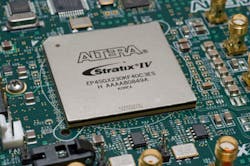AS DATA RATE DEMANDS continue their rapid increase, engineers have been forced to look beyond copper and traditional optical solutions in order to meet the performance, cost, and power demands of bandwidth-intensive applications.
With an eye toward fulfi lling that need, Altera Corp. recently demonstrated its new optical field-programmable-gate-array (FPGA) technology. Developed in conjunction with Avago Technologies, the demonstration showed the potential for Altera's optically interconnected programmable devices to increase interconnect bandwidth while reducing overall system complexity, power, and price.
The demonstrationwhich took place at the Optical Fibre Communication Conference and Exposition (OFC), held in Los Angeles, CA March 6-8featured the Optical FPGA technology on a test board derived from Altera's Stratix IV FPGA 100G development kit, integrated with 12-Channel MicroPOD optical modules from Avago. By integrating high-speed optical transceivers onto the package that holds the FPGA, the electrical signal path from the I/O pad of the chip to the input of the optical transceiver was reduced to a fraction of an inch. This shorter path reduced signal degradation and jitter, improving signal integrity and reducing data errors caused by parasitic elements in the signal path. Such integration can also help engineers reduce their overall board development and engineering costs.
In a loopback configuration, the demonstration showed 100GbE traffic of assorted packet sizes sent and received using the chip's internal traffic generator. The data path is sent back and forth through the FPGA transceivers and optical modules to achieve a bit error rate (BER) of 10-12 or less. The short routing distance keeps signal integrity high and the emitted electromagnetic interference very low.
Digital diagnostics monitoring (DDM), such as module case temperature and laser bias current, was also shown detecting potential issues and preventing link loss. This has important ramifications for data center applications, where link downtimes can mean significant lost revenue. Finally, the demonstration spotlighted the FPGA's unique heat-sinking capability, which ensures the optics stay within a standard 0 to +70C temperature range.
